 W
WDuring the American Civil War, Arkansas was a Confederate state, though it had initially voted to remain in the Union. Following the capture of Fort Sumter in April 1861, Abraham Lincoln called for troops from every Union state to put down the rebellion, and Arkansas and several other states seceded. For the rest of the war, Arkansas played a major role in controlling the Mississippi River, a major military highway.
 W
WThe Arkansas Militia in Reconstruction was deeply involved in the ongoing civil disturbances which plagued the state until the late 1870s. In the immediate aftermath of the Civil War, the militia was first utilized by the white population to re-establish control over the newly freed black population. Radical Republicans seized control in 1867 and abolished existing state governments and militia organizations, and disenfranchised former Confederates. The new disenfranchised whites turned to the shadow Ku Klux Klan to attempt to maintain social order. The Re-constructionist government raised a new militia, primarily of black soldiers with white officers and utilized this new "Black Militia" to put down the rising power of the Ku Klux Klan. Armed conflicts between rival parties continued in several counties and the Militia was called to re-establish control in Pope and Scott Counties. The most severe conflict of this period occurred during the so-called Brooks–Baxter War with rival parties, with supporting militias, battling for control of the governorship. With the end of reconstruction one of the first acts of the new resurgent Democratic state legislature was to abolish the office of Adjutant General in retaliation for the use of the militia to enforce the rule of the Reconstruction government.
 W
WThe units of the Arkansas Militia in the Civil War to which the current Arkansas National Guard has a connection include the Arkansas State Militia, Home Guard, and State Troop regiments raised by the State of Arkansas. Like most of the United States, Arkansas had an organized militia system before the American Civil War. State law required military service of most male inhabitants of a certain age. Following the War with Mexico, the Arkansas militia experienced a decline, but as sectional frictions between the north and south began to build in the late 1850s the militia experienced a revival. By 1860 the state's militia consisted of 62 regiments divided into eight brigades, which comprised an eastern division and a western division. New regiments were added as the militia organization developed. Additionally, many counties and cities raised uniformed volunteer companies, which drilled more often and were better equipped than the un-uniformed militia. These volunteer companies were instrumental in the seizure of federal installations at Little Rock and Fort Smith, beginning in February 1861.
 W
WThe Arkansas Post was the first European settlement in the lower Mississippi River Valley and present-day Arkansas when Henri de Tonti established it in 1686 as a French trading post on the banks of the lower Arkansas River. The French and Spanish traded with the Quapaw for years, and the post was of strategic value to the French, Spanish, and Americans. It was designated as the first capital of the Arkansas Territory in 1819, but lost that status to Little Rock in 1821. During the years of fur trading, Arkansas Post was protected by a series of forts. The forts and associated settlements were located at three known sites and possibly a fourth, as the waterfront area was prone to erosion and flooding.
 W
WThe Battle of Arkansas Post, also known as Battle of Fort Hindman, was fought from January 9 until 11, 1863, near the mouth of the Arkansas at Arkansas Post, as part of the Vicksburg Campaign of the American Civil War. Although a Union victory, it did not move them any closer to Vicksburg.
 W
WThe Battle of Bayou Fourche, also known as Engagement at Bayou Fourche or Battle of Little Rock, was a minor conflict of the American Civil War, and the principal engagement of the Little Rock Campaign. It was fought on September 10, 1863, in Pulaski County, Arkansas, near the Bayou Fourche, and was the culmination of a month-long offensive launched by U.S. Army Major-General Frederick Steele on August 1, 1863, to capture the capital of Arkansas. The campaign included engagements at West Point, Harrison's Landing, Brownsville, Bayou Meto, and Ashley's Mills.
 W
WThe Battle of Elkin's Ferry, also known as Engagement at Elkin's Ferry, was fought in Clark and Nevada counties in Arkansas as part of the Camden Expedition, during the American Civil War.
 W
WThe Battle of Jenkins' Ferry, also known as the Engagement at Jenkins' Ferry, was fought at Jenkins' Ferry, southwest of Little Rock, during the American Civil War. It was the climactic battle of Steele's Camden Expedition, a part of the Red River Campaign. As a result of the battle, Federal forces were able to complete a retreat from a precarious position at Camden to their defenses at Little Rock.
 W
WThe Battle of Pine Bluff, also known as the Action at Pine Bluff, was a battle of the American Civil War. The battle was fought on October 25, 1863, in Jefferson County, Arkansas, near the county courthouse, where the U.S. garrison under the command of Col. Powell Clayton successfully defended the town against attacks led by Confederate Brig. Gen. John S. Marmaduke. The Union victory ensured the safety of the garrison until the end of the war.
 W
WThe Battle of Poison Spring was fought in Ouachita County, Arkansas on April 18, 1864, as part of the Camden Expedition, during the American Civil War. A Union force commanded by Major General Frederick Steele had moved from Little Rock, Arkansas towards Shreveport, Louisiana in support of Major General Nathaniel Banks' move up the Red River towards Shreveport. After Banks was defeated at the battles of Mansfield and Pleasant Hill, Steele was isolated in Arkansas. Short on supplies, Steele sent a detachment commanded by Colonel James M. Williams to search for supplies. Williams' column was attacked by Confederate troops under the command of Brigadier Generals John S. Marmaduke and Samuel B. Maxey. After a sharp fight, Williams' command was routed, losing its wagon train and four cannons. The defeat at Poison Spring, as well as another defeat at the Battle of Marks' Mills a week later led Steele to decide to retreat back to Little Rock. The battle is infamous for the Confederates' slaughter and mutilation of African-American Union soldiers of the 1st Kansas Colored Infantry. Poison Springs Battleground State Park, which is part of the Camden Expedition Sites National Historic Landmark, preserves a portion of the site of the battle.
 W
WThe Battle of Prairie D'Ane, also known as the Skirmish at Prairie D'Ane, Battle of Gum Springs or Battle of Moscow, was fought in present-day Nevada County, Arkansas, as part of the Camden Expedition, during the American Civil War. The Camden Expedition was launched by Union forces as part of the Red River Campaign of 1864. U.S. planners envisioned two federal armies converging simultaneously, one force under the command of Maj. Gen. Nathaniel Banks pressing northward up the Red River commencing at Alexandria, Louisiana and the other federal army under the command of Maj. Gen. Frederick Steele driving southwestward from Little Rock, Arkansas. The objective was to press the rebel army of Gen. E. Kirby Smith back upon the rebel stronghold at Shreveport and defeat him. If successful, a somewhat vague second phase envisioned the two federal armies combining into one large force and continuing their offensive with a westward push into Texas.
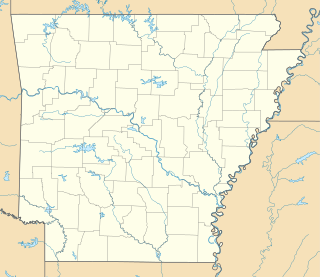 W
WThe Camden Expedition was the final campaign conducted by the United States Army against the Confederate States Army in Arkansas, during the American Civil War. The offensive was designed to cooperate with Maj. Gen. Banks' movement against Shreveport.
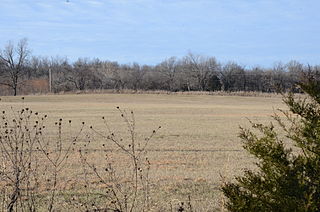 W
WThe Cane Hill Battlefield is a historic district encompassing the battlefield of the Battle of Cane Hill, fought during the American Civil War on November 28, 1862, in and around the site of present-day Cane Hill, Arkansas. Because the battle was a running battle that extended over many hours and 12 miles (19 km) of roads, the battlefield is more than 5,700 acres (2,300 ha) in size, extending in all directions around Cane Hill. The northern section of the battlefield is an agricultural area that is little-altered except for the introduction of new roadways and rural buildings, and the abandonment of old roadway alignments. The southern section is hillier and more wooded, and is altered in similar ways.
 W
WThe Battle of Cotton Plant saw a 10,000-strong Union Army commanded by Samuel Ryan Curtis encounter a 5,000-man Confederate force led by Albert Rust. A Union advance guard commanded by Charles Edward Hovey did most of the fighting, repelling an attack by two Texas cavalry regiments led by William Henry Parsons. Union reinforcements under William P. Benton arrived and pressed the Texas cavalry and Arkansas infantry into a disorderly retreat. Curtis's army subsequently occupied Helena. Earlier in the campaign, Texas cavalry inflicted 49 casualties on a Union foraging party in the Battle of Whitney's Lane near Searcy on May 19, 1862. At the Battle of L'Anguille Ferry near Marianna on August 3, 1862 the Texas cavalry overran a Union wagon convoy.
 W
WElkhorn Tavern is a two-story, wood-frame structure that served as a physical center for the American Civil War Battle of Pea Ridge, also known as the Battle of Elkhorn Tavern, which was fought on March 7 and March 8, 1862, approximately five miles east of Pea Ridge, Arkansas, located in the northeastern Benton County, Arkansas. The tavern, a replica built in 1865 following the burning of the original building by bushwhackers, is now the centerpiece of the Pea Ridge National Military Park, which includes approximately 5,000 acres (2,000 ha) around the structure, including the restored battlefields, a stretch of the pre-war Telegraph Road, which runs directly in front of the tavern, and a section of the Trail of Tears. The tavern is on the National Register of Historic Places.
 W
WEunice is a ghost town on the east bank of the Mississippi River in Chicot County, Arkansas, United States.
 W
WFort Smith National Cemetery is a United States National Cemetery located at Garland Avenue and Sixth Street in Fort Smith, Sebastian County, Arkansas. It encompasses 22.3 acres (9.0 ha), and as of the end of 2005, had 13,127 interments.
 W
WFort Smith National Historic Site is a National Historic Site located in Fort Smith, Arkansas, along the Arkansas River. The first fort at this site was established by the United States in 1817, before this area was established as part of Indian Territory. It was later replaced and the second fort was operated by the US until 1871. This site was designated as a National Historic Landmark in 1961.
 W
WThe Grand Army of the Republic Monument of Judsonia, Arkansas is located in the city's Evergreen Cemetery, on Judson Avenue north of its downtown. The monument consists of a rusticated fieldstone base, on which a cubical stone with inscriptions has been set. This is topped by an obelisk-like tapering marble element with a square cross section, which is topped by a sphere adorned with floral detailing. It is set in a square area 31 feet (9.4 m) on each side, in which a number of Union Army soldiers are buried. The monument was placed in 1894 by the local chapter of the Grand Army of the Republic, a Union Army veterans' organization. White County, where Judsonia is located, was divided in the war, with men from the county serving on both sides in the conflict.
 W
WThe Grand Army of the Republic Memorial is a monument in Twin Springs Park of Siloam Springs, Arkansas. Located in the southern part of the park, it consists of a concrete foundation, on which rest two tiers of granite slabs, laid horizontally. These are topped by a vertical granite column that has an onion form at the top. The sides of the horizontal slabs are rusticated, as are three sides of the column. The fourth side is engraved, from the top down, with an inverted five-point star labelled "GAR", then the words "IN GOD WE TRUST", then a Maltese cross engraved "WOMEN'S RELIEF CORPS 1833", then "ERECTED BY/CURTIS POST/1928", and finally a wreath topped by an eagle and crossed cannons, with "US" in the center surrounded by "PRESERVED BY THE GRACE OF GOD". The memorial was placed in 1928, and is the only known memorial statewide to mention the Grand Army's Women's Relief Corps.
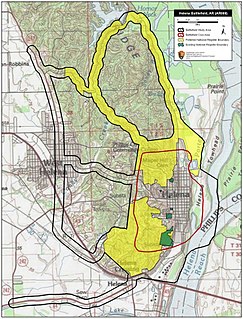 W
WThe Battle of Helena, also known as the Attack on Helena, was a battle of the American Civil War fought on July 4, 1863, in Helena, Arkansas. The battle was a failed Confederate attempt to relieve pressure on the besieged city of Vicksburg. The Union victory at Helena paved the way for the fall of Little Rock.
 W
WHistoric Washington State Park is a 101-acre (41 ha) Arkansas state park in Hemsptead County, Arkansas in the United States. The museum village contains a collection of pioneer artifacts from the town of Washington, Arkansas, which is a former pioneer settlement along the Southwest Trail. Walking interpretive tours are available throughout the 54 buildings. Washington served as a major trading point along the Southwest Trail, evolving into the Hempstead county seat and later the capital of Arkansas from 1863 to 1865 when Little Rock was threatened during the Civil War. The original plat of Washington was added to the National Register of Historic Places in 1972 as the Washington Historic District.
 W
WThe Huntsville massacre refers to the execution during the Civil War of nine local men, including three Confederate soldiers, by Union soldiers on January 10, 1863, in Huntsville, Arkansas. No formal charges were filed, and the commanding officer was later discharged by the US Army. The prisoners may have been suspected of being Confederate sympathizers. A few months before, guerrillas had attacked a force of 25 Union troops in the area.
 W
W"Marching Song of the First Arkansas Colored Regiment" is one of the few Civil War-era songs inspired by the lyrical structure of "The Battle Hymn of the Republic" and the tune of "John Brown's Body" that is still performed and recorded today. The "Marching Song" has been described as "a powerful early statement of black pride, militancy, and desire for full equality, revealing the aspirations of black soldiers for Reconstruction as well as anticipating the spirit of the civil rights movement of the 1960s." The song's lyrics are attributed to the regiment's white officer, Captain Lindley Miller. An almost identical song, "The Valiant Soldiers," is attributed to Sojourner Truth in post-Civil War editions of her Narrative. Recent scholarship supports Miller as the original author, or at least compiler, of the song.
 W
WThe Confederate government of Missouri was a continuation in exile of the government of pro-Confederate Governor Claiborne F. Jackson. It existed until General E. Kirby Smith surrendered all Confederate troops west of the Mississippi River at New Orleans, May 26, 1865.
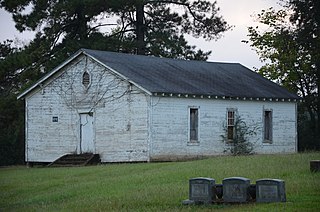 W
WMoscow Methodist Church and Cemetery is a historic landmark that was built in 1864 and added to the National Register in 2006. The former community of Moscow is located just outside the current city limits of Prescott, Arkansas. The area is on or near the old "Moscow-Camden Road", or "Wire Road" which ran between Moscow and Camden, Arkansas. As of 2016, the location was known as the junction of Nevada County Roads 23 and 260.
 W
WNapoleon was a river port town in Desha County, Arkansas, United States, from the 1820s until 1874. It was situated at the confluence of the Arkansas and Mississippi rivers. Once the county seat, Napoleon's fate was sealed when in 1863, a channel was cut through the soft land that directed the river waters toward the town. Napoleon was finally deserted and the county seat moved in 1874 when the banks of the Mississippi River overflowed and destroyed much of what remained of the once-thriving river port town.
 W
WThe Old State House, formerly called the Arkansas State House, is the oldest surviving state capitol building west of the Mississippi River. It was the site of the secession convention, as well as the fourth constitutional convention when delegates agreed to ensure voting rights for freedmen and establish public education.
 W
WThe Old Wire Road is a historic road in Missouri and Arkansas. Several local roads are still known by this name. It followed an old Native American route, the Great Osage Trail across the Ozarks and became a road along a telegraph line from St. Louis, Missouri, to Fort Smith, Arkansas. This route was also used by the Butterfield Overland Mail. It was known as the "Wire Road" while the telegraph line was up, but when the line was later removed, it simply became known as the "Old Wire Road". In St. Louis, where the road begins at Jefferson Barracks, it is called Telegraph Road. From St. Louis to Springfield, Missouri, it became designated Route 14.
 W
WPea Ridge National Military Park is a United States National Military Park located in northwest Arkansas near the Missouri border. The park protects the site of the Battle of Pea Ridge, fought March 7 and 8, 1862. The battle was a victory for the Union, and helped it gain control of the crucial border state of Missouri.
 W
WThe Battle of Pea Ridge, also known as the Battle of Elkhorn Tavern, took place in the American Civil War near Leetown, northeast of Fayetteville, Arkansas. Federal forces, led by Brig. Gen. Samuel R. Curtis, moved south from central Missouri, driving Confederate forces into northwestern Arkansas.
 W
WPine Bluff is the tenth-largest city in the state of Arkansas and the county seat of Jefferson County. It is the principal city of the Pine Bluff Metropolitan Statistical Area and part of the Little Rock-North Little Rock-Pine Bluff Combined Statistical Area. The population of the city was 49,083 in the 2010 Census with 2019 estimates showing a decline to 41,474.
 W
WThe Prairie D'Âne Battlefield, also known as Prairie D'Ann Battlefield or Prairie De Ann Battlefield in anglicized forms, was the site of the Civil War Battle of Prairie d'Âne, one of the engagements in southwestern Arkansas of the Union's Camden Expedition of 1864. It was listed on the National Register of Historic Places in 1974, and, with other sites, is part of the Camden Expedition Sites National Historic Landmark. It was declared part of the National Historic Landmark in 1994.
 W
WPrairie Grove Battlefield State Park is an Arkansas state park located next to Prairie Grove. It commemorates the Battle of Prairie Grove, fought December 7, 1862, in the American Civil War. The battle secured northwestern Arkansas for the Union.
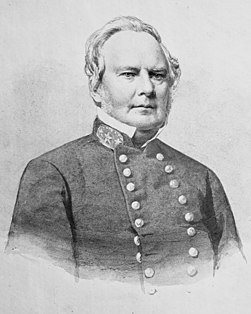 W
WMajor-General Sterling Price was a senior officer of the Confederate States Army who fought in both the Western and Trans-Mississippi theaters of the American Civil War. He rose to prominence during the Mexican–American War and served as governor of Missouri from 1853 to 1857. He is remembered today for his service in Arkansas (1862–65), and his defeat at the battle of Westport on October 23, 1864.
 W
WPrice's Missouri Expedition, also known as Price's Raid or Price's Missouri Raid, was an unsuccessful Confederate cavalry raid through the states of Arkansas, Missouri, and Kansas in the Trans-Mississippi Theater of the American Civil War. Led by Confederate Major-General Sterling Price, the campaign's intention was to recapture Missouri and renew the Confederate initiative in the larger conflict.
 W
WThe St. Charles Battle Site is the area near St. Charles, Arkansas where the Battle of Saint Charles took place on June 17, 1862, during the American Civil War. The battle was a land and naval engagement, in which Union gunboats engaged Confederate shore batteries and gunboats in a firefight, while infantry troops were landed on the western bank of the White River and eventually drove the Confederate forces from their shore batteries. The battle site occupies about 9 acres (3.6 ha) on the west bank the River southeast of Saint Charles. There are no signs left of the Confederate batteries, and the area is an undeveloped swampland, as it was in 1862.
 W
WThe Tower Building of the Little Rock Arsenal, also known as the Main Building of the U.S. Arsenal at Little Rock, or Headquarters Building of the Little Rock Barracks, is the home of the MacArthur Museum of Arkansas Military History. It is also a part of the MacArthur Park Historic District, in Little Rock, Arkansas.
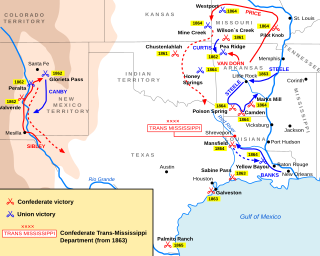 W
WThe Trans-Mississippi Theater of the American Civil War consists of the major military operations west of the Mississippi River. The area is often thought of as excluding the states and territories bordering the Pacific Ocean, which formed the Pacific Coast Theater of the American Civil War (1861–1865).